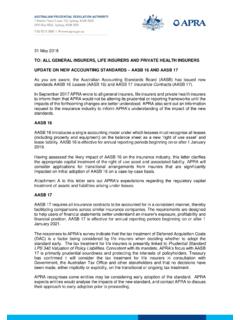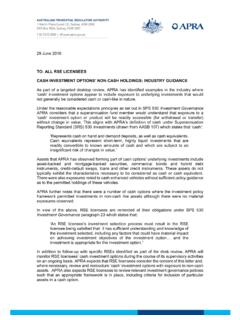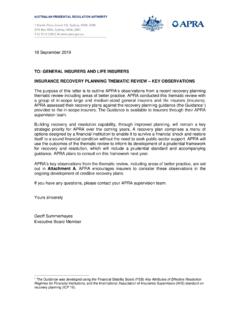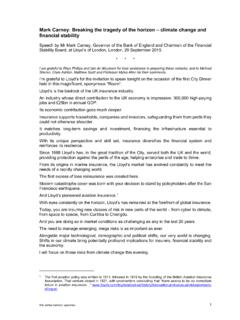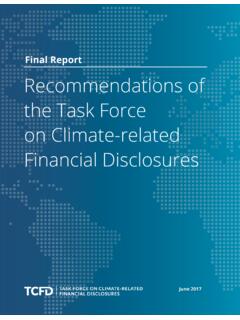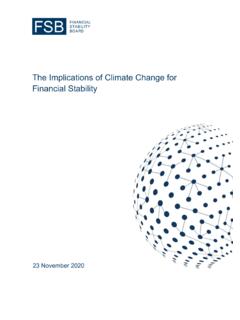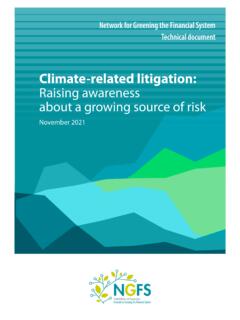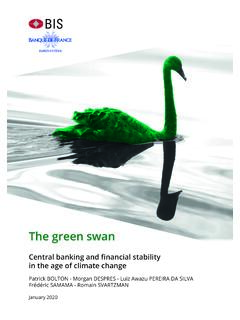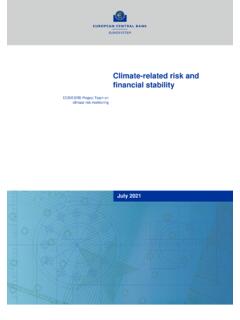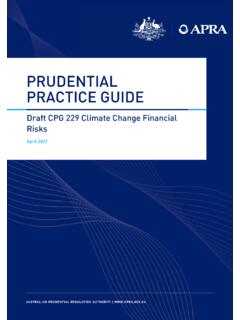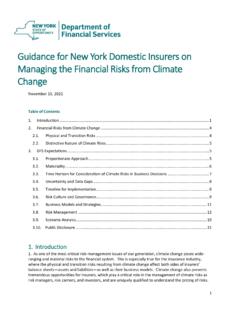Transcription of Final Prudential Practice Guide CPG 229 Climate Change ...
1 Prudential Practice Guide Prudential Practice Guide CPG 229 Climate Change financial Risks November 2021 Disclaimer and Copyright This Prudential Practice Guide is not legal advice and users are encouraged to obtain professional advice about the application of any legislation or Prudential standard relevant to their particular circumstances and to exercise their own skill and care in relation to any material contained in this Guide . APRA disclaims any liability for any loss or damage arising out of any use of this Prudential Practice Guide .
2 Australian Prudential Regulation Authority (APRA) This work is licensed under the Creative Commons Attribution Australia Licence (CCBY ). This licence allows you to copy, distribute and adapt this work, provided you attribute the work and do not suggest that APRA endorses you or your work. To view a full copy of the terms of this licence, visit AUSTRALIAN Prudential REGULATION AUTHORITY 2 Contents About this Guide 4 Introduction 5 The financial risks of Climate Change 7 Governance 10 Risk management 12 Policies and procedures 12 Risk identification 12 Risk monitoring 13 Risk controls 14 Risk reporting 15 Scenario analysis 16 Disclosure 19 AUSTRALIAN Prudential REGULATION AUTHORITY 3 About this Guide Prudential Practice guides (PPGs)
3 Provide guidance on APRA s view of sound Practice in particular areas. PPGs frequently discuss legal requirements from legislation, regulations or APRA s Prudential standards, but do not themselves create enforceable requirements. This PPG aims to assist an APRA-regulated institution in complying with Prudential Standards CPS 220 Risk Management (CPS 220), SPS 220 Risk Management (SPS 220), CPS 510 Governance (CPS 510), SPS 510 Governance (SPS 510) and, more generally, to outline prudent practices in relation to Climate Change financial risk management.
4 In this PPG, the term: Climate risks refers to the financial risks arising from Climate Change , including physical, transition and liability risks; and APRA-regulated institution refers to an authorised deposit-t aking institution (ADI), a registrable superannuation entity (RSE) licensee (RSE licensee), a general insurer, a life company (including friendly societies), a private health insurer, an authorised non-operating holding company (NOHC) and, where applicable, Level 2 and Level 3 groups. This PPG is designed to be read together with CPS 220, SPS 220, CPS 510 and SPS 510, but does not address all Prudential requirements in relation to risk management and governance.
5 Subject to meeting the requirements of the Prudential standards, an APRA-regulated institution has the flexibility to configure its approach to Climate risk management in a manner best suited to achieving its business objectives. Not all of the practices outlined in this PPG are relevant for every institution, and some aspects may vary depending upon the size, business mix and complexity of the institution. AUSTRALIAN Prudential REGULATION AUTHORITY 4 Introduction risks of a changing Climate extend to all sectors of the economy.
6 The need to adapt to the changing Climate will also bring new business opportunities. Within the financial sector, a prudent institution will consider both the financial opportunities and the financial risks of Climate Change as it sets its s mandate is to ensure that, under all reasonable circumstances, financial promises made by APRA-regulated institutions are met within a stable, efficient and competitive financial system. APRA is seeking to ensure that APRA-regulated institutions manage the risks and opportunities that may arise from a changing Climate in line with APRA s approach to other types of information in this Guide does not impose new requirements in relation to Climate risks: rather, it supports compliance with APRA s existing risk management and governance requirements and provides guidance to assist an institution to manage Climate risks (Figure 1).
7 In keeping with APRA s mandate, this guidance does not seek to determine an institution s individual investment, lending or underwriting decisions, but does aim to ensure that these decisions are PPG reflects the established framework for considering and managing Climate risks developed by the financial stability Board s Task Force on Climate -related financial Disclosures (TCFD)11 financial stability Board Task Force on Climate -related financial Disclosures, Final Report: Recommendations of the task force on Climate -related financial disclosures (June 2017).
8 , as well as good Practice observed through APRA s own analysis. AUSTRALIAN Prudential REGULATION AUTHORITY 5 Figure 1. Overview of APRA s Climate Change financial risk guidance AUSTRALIAN Prudential REGULATION AUTHORITY 6 The financial risks of Climate Change financial risks of Climate Change , including physical Climate risks, transition climaterisks, and liability risks (Figure 2) are referred to in this guidance collectively as Climate risks, including both longer-term changes in Climate (chronic risk) aswell as changes to the frequency and magnitude of extreme weather events (acute risk)
9 ,can cause direct damage to assets or property, changes to income and costs, andchanges to the cost and availability of Climate risks include risks related to changes in domestic and internationalpolicy and regulatory settings, technological innovation, social adaptation and marketchanges, which can result in changes to costs, income and profits, investmentpreferences and asset Change may also give rise to liability risks which have implications forbusinesses and directors duties. Liability risks stem from the potential for litigationwhere institutions and boards do not adequately consider or respond to the impacts ofclimate 2.
10 Climate Change financial risks prudent institution would take a strategic and risk-based approach to the managementof the various risks and opportunities arising from Climate Change , recognising theunique nature and far-reaching potential impacts of a changing is important for institutions to understand the interaction between Climate risks andtheir business activities, including the compounding effect Climate risks may have on aninstitution s other risks, including:AUSTRALIAN Prudential REGULATION AUTHORITY 7 a)credit risk through a potential increase in defaults on loans by businesses andhouseholds that may be affected by adverse Climate events, as well as the potentialfor assets used as collateral to decline in value;b)market risk through the impact of potential re-pricing of financial instruments andcorporate debt affecting the value of securities held on an institution s balancesheet.



